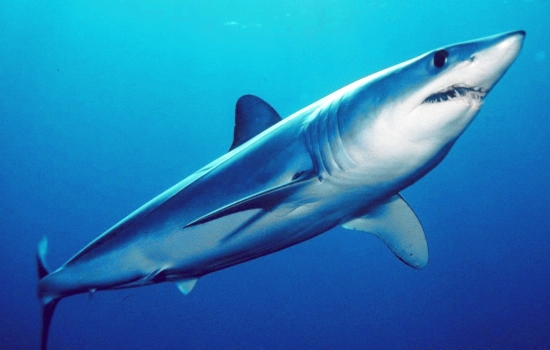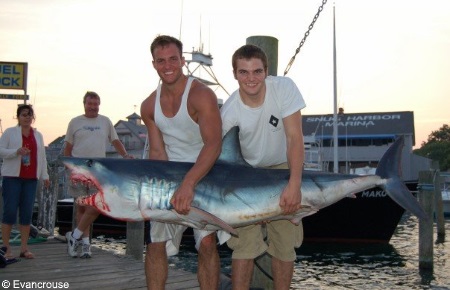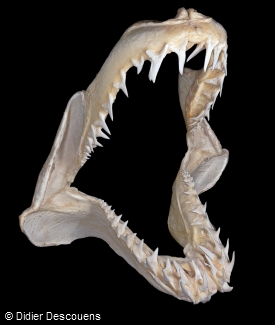
- Scientific name: Isurus oxyrinchus
- Size: Up to 14ft in length and 1300lbs+. Mako found in British waters are generally 300 – 500lb.
- UK minimum size: N/a
- UK shore caught record: No record stands. Qualifying weight set at 40lbs.
- IGFA world record: 1221lb
- IUCN status: EN (Endangered)
- Distribution: Widespread distribution throughout the sub-tropical and temperate seas of the world. In British waters they are found off the south and west coasts.
- Feeds on: Any fish which will fit into their mouths and will also take small seals.
- Description: Strong, powerful and streamlined body with large gill slits. The snout is pointed, eyes are relatively large and the large mouth is full of rows of sharp teeth. Pectoral fins are large, no second caudal keel is present. Colour usually a dark grey on the back and flanks, fading to white on the underbelly.
The shortfin mako shark is a large shark, which is also thought to be the fastest swimming species of shark in the world. Many people are surprised to hear that such a large predator is present in British waters, but – although rare – this species is certainly found from time to time in the seas around the UK and Ireland, and with rising sea temperatures this species could become more common.
Distribution and Life Cycle
Shortfin mako sharks are found off the coasts of Africa, South America, the Caribbean, Australia, India and Pakistan. In European waters they are at the limit of their distribution but are certainly confirmed as being present in British waters, mostly off the coasts of southern and western England, parts of Wales and Ireland, but they have been sighted all around the British Isles. In September 2013 boat anglers reported seeing mako sharks off the coast of Cornwall, while in December 2014 a 10ft mako shark washed up on a Welsh beach.
Like porbeagle sharks, mako sharks have the ability to elevate their body temperature to levels higher than the waters around them by conserving heat from muscles in special blood vessels. This allows the shortfin mako to live and feed in relatively cold waters. Shortfin mako generally hunt for prey between the midwater mark and the surface. Unlike the porbeagle shark which usually stays miles away from land the shortfin mako has been known to swim relatively close to the shore. Shortfin mako are nomadic and can cover huge distances over their lives. Some shortfin makos tagged in the Mediterranean have been caught in American waters, proving this species can make migrations across the Atlantic Ocean. It is believed that many of the mako sharks spotted in British and Irish waters are in the process of making this migration.
Other Species of Mako Shark

There is a second species of mako shark – the longfin mako (Isurus paucus). This species looks extremely similar to the shortfin mako, with the much longer pectoral fins providing the only major difference between the two species. The longfin mako lives in the warmer waters around the equator and does not come into the colder, temperate waters around Britain and Ireland. The longfin mako can reach similar sizes to the shortfin mako and is also a powerful and aggressive predator which also feeds in midwater by hunting fish and squid. However, the longfin mako is not capable of matching the great swimming speeds that its shortfin relative can reach.
Commercial Value and Conservation Status

The shortfin mako is commercially valuable for its edible flesh, skin (which is made into leather) and dorsal fin which is used in shark fin soup. In addition to this the jaws of the shortfin mako shark can also be turned into a form of ornament or trophy. Most shortfin mako are caught on longlines meant for various tuna species, and they may also be caught in gill nets, seine nets and by trawlers. Catches of shortfin mako are poorly recorded in many parts of the world with few quotas or regulations on catching this species existing, and the practice of finning (removing the dorsal fin and then returning the fish to the sea) continues in many countries. In Europe Spanish and Portuguese fishermen are responsible for the majority of mako shark catches, with much of what they catch being exported to China. The EU has been heavily criticised by shark conservation groups such as Shark Advocates International and the UK’s Shark Trust, as EU vessels make up two-thirds of mako shark catches, but the EU has done very little to protect this species. In 2020 the US and EU blocked plans for further protection for shortfin makos when they refused to back a ban proposed by Canada as they claimed it would not prevent bycatch.
Shortfin mako were previously classed as Vulnerable by the IUCN but in 2019 this was changed to Endangered on a global basis with a declining population trend. Numbers of mature mako sharks are sharply reduced compared to previous years and this species is now rare in areas of the Mediterranean (where it is classed as Critically Endangered), and while this species has never been common in British waters it is now much rarer than it was in the 1960s and 1970s. Shortfin mako have a long gestation period of 16 – 20 months, although they are relatively fast-growing meaning that numbers may recover faster than that of other shark species if the intensity of commercial fishing is reduced.
Sport Fishing for Shortfin Mako
Due to its size, aggressiveness and the fact that it will make spectacular jumps out of the sea when hooked the shortfin mako is a highly prized big game fish which is targeted by boat anglers wherever it is present. Catching a shortfin mako on a rod and line requires the strongest fishing tackle with big game rods and reels loaded with hundreds of metres of line with a breaking strain of at least 50lb. The terminal rig usually consists of heavy wire line, a size 12/0 hook and a longer rubbing leader of heavy 200lb mono as the shark’s rough skin is capable of damaging and potentially snapping weaker line. Baits – usually full large mackerel or similar oily fish – are suspended in mid-water, and sharks are attracted to the boat with chum or rubby-dubby. Due to their immense power mako sharks must be played for a considerable amount of time before they can be reeled to the boat. Most recreational fishing for shortfin mako sharks takes place off the coasts of America, Australia, New Zealand and in the Mediterranean. Due to the declining numbers of shortfin mako sharks there have been campaigns by organisations such as the NOAA (National Oceanic and Atmospheric Administration) of the United States to encourage anglers who catch shortfin mako to release the sharks back into the sea and not kill or retain any shortfin mako that they catch.

The British record for a rod and line boat caught shortfin mako is a 500lb specimen caught by 61-year-old grandmother Joyce Yallop who was fishing north-west of Eddystone Reef off the coast of Looe, Cornwall in 1971. This record could have been beaten in 2020 when charter boat owner Rob Rennie caught an 11ft long mako shark which was estimated at 800 – 1200lb off the west coast of Wales. The shark was too big to take on board the vessel he was fishing from and was released after being brought alongside the boat. Current rules mean that any fish being put forward for a record must be weighed on land which would have meant killing the shark, although Mr Rennie said that he hoped to have the record granted on the basis of the measurements and photographic evidence of the shark. The international IGFA (International Game Fish Association) certified world record was a mako shark of 1,221 pounds, caught by Luke Sweeney off the coast of Chatham, Massachusetts in 2001.
Feeding, Speed and Attacks on Humans

Unsurprisingly, the shortfin mako shark is an apex predator (i.e. one which has no natural predators when fully grown). They will feed on all manner of fish, usually mackerel and herring in British waters, as well as squid. Elsewhere in the world, the shortfin mako will feed on pretty much any fish that it comes across with larger species such as skipjack tuna, cod, bass and bonito. The shortfin mako is also known to be one of the fastest swimming sharks in the world, easily reaching speeds of 20 – 25mph, and possibly able to hit speeds of over 40mph in short bursts. The shortfin mako is also able to jump out of the water, reaching heights of 15 – 20ft. Shortfin mako are especially liable to do this when hooked by boat anglers. Despite being a powerful predator the shortfin mako is similar to the UK’s other large shark species (blue shark and the porbeagle) in that it is unlikely to attack humans unless it is provoked. The International Shark Attack File lists forty-two mako shark attacks on humans since 1980, three of which have been confirmed as being fatal.